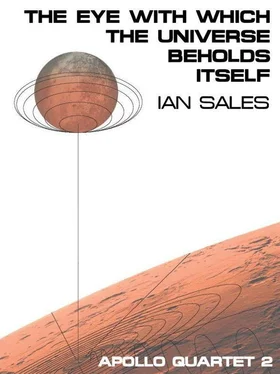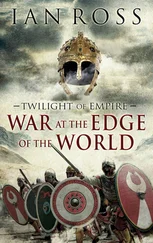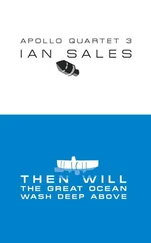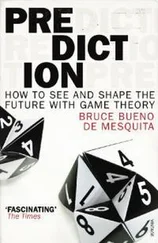There’s only one place he’s got left to look: the D&M Pyramid, and it’s six miles south of the MM, just over an hour’s drive in this terrain in the MRV. He shouldn’t go so far, mission protocols say stay within walking distance of the MM, but it’s not like he has much choice. He’s got to find something .
The Pyramid is a good bet because it looks just like one of the pyramids in Egypt. Except it has five sides. The top has been scoured flat by dust storms, and the edges are no longer sharp, but there’s no way it can be a natural hill. He pushes the T-bar forward and the MRV picks up speed, throwing out two fine plumes of red dust from its rear wheels. The ground is soft, but at least it’s mostly flat, and the wire wheels have more than enough traction so soon he’s hitting nearly eight miles per hour. He crests a small dune around three feet high, and bounces down the other side. He’s getting the hang of the low gravity now, his reactions are tuned to it. He speeds across the Martian sand and he can’t help himself, for the first time since landing here he’s feeling happy. The sun is a small white spot, mountains dance in the haze of distance, banded and striped in shades of red and brown and black, and the sky above the horizon is a salmon pink blur. He hits a shallow graben, like an empty stream-bed, and pulls back on the T-bar to reduce speed. If he hits one of those too fast, he’ll bust the MRV and it’s a long walk back to the Mars Module.
Two and a half miles before the Pyramid is a big round crater five or six hundred yards across. He was going to ignore it, drive round it, but now that he’s close something about it puzzles him. There’s no ejecta, no apron, the rock of the rim is the same basalt as the Pyramid and the surrounding area. He can see no discolouration, no debris where an ejecta blanket should be.
He reaches the rim of the crater—or whatever it is—and brings the MRV to a slewed halt. He unfastens his lap belt but waits a moment before climbing off the vehicle. He’s on VOX but none of this conversation is going to get relayed to Houston:
Okay, Bob, I’m at the crater, and it’s no crater, man. It’s like a collapsed cave or something.
I hope you’re taking photos, Brad.
Yeah, but you just know they’re going to be classified, right?
[laughter] It’s probably natural; it’s just you, your mix is just wrong. So what kind of cave?
Could be erosional, I guess, formed back when Mars had water back in the Noachian.
That’s four billion years ago, Brad. That can’t be right: Cydonia is Amazonian.
Yeah, I guess. I’m standing on the rim now. I’m seeing banding in the walls, so this is no impact crater. And those walls are way too regular, so it’s not erosional either—
You’re saying it’s artificial?
Yeah, I guess… Wait—
On the Viking 1 image, part of the “crater” floor looked to be in shadow but now he’s standing on the lip he can see from edge to edge. And over there, across from him, something glints in a drift against the wall. He looks for a way down—the chamber is about fifty feet deep and sheer-sided—and just around the rim, part of the wall has collapsed, forming a steep slope down. He heads over, kicking up red sand as he bounds across the Martian soil. He weighs 150 pounds here with his spacesuit and PLSS, and that’s just over half of what he weighs buck naked on Earth. He reaches the ramp, and steps carefully onto it, placing one boot firmly on the slope, then lifting his foot. For a moment, he admires the bootprint he’s made in the red sand, but already grains are spilling in at the edges, blurring its clean lines. He puts his foot down again and his grip feels secure. This ramp has been here for hundreds of thousands of years, maybe longer, the rock and sand is not going to shift from his weight.
Still, he’s careful as he descends, but it’s steeper than it looks and he starts to lose his balance so he increases his pace and soon he’s springing from foot to foot down the ramp, always about to topple over, only just in control—
You okay, Brad?
I’m… shit… steep… steeper… than… I thought… shit… Okay, I’m at the bottom now. Damn, that was stupid.
Bottom of what, Brad?
I’m on the floor. I saw something, I’m going to check it out.
He heads across the floor of the—yes, it’s a chamber, a built thing, carved from the rock. He’s hot and his ankles ache and the soles of his feet are sore from descending the ramp at speed. He shuffles across the sandy red rock, scuffing through the drifts of sand, rocking from side to side, and it’s hard work. He can see the glint more clearly now, and once he’s within a dozen feet of it he sees it’s a curved fragment of transparent mineral. It’s too big to be natural, he thinks, but with the Face and now this underground chamber, he’s lost all sense of surprise.
He bends forward, preventing himself from falling over with a hand to the drift, and tries to dig away at it. But the transparent thing, whatever it is, it’s buried deep in the rock, and he can’t get it out. All he does is bruise his fingertips badly in the thimbles of his gloves, and he has to bite back an oath at the pain. He wonders if it’s worth getting it out, but just then some of the rock crumbles and falls away and he can see a bit more of the sheet and—
There’s something inside it.
It’s black and thin and curved, but he can’t see more than that. It’s like a tiny black worm maybe, or a tail of some small creature. He’s got a geology hammer but he left it on the MRV. He’s going to need it now.
He heads back across the floor, scrambles up the ramp, and by the time he reaches the top, he has to stop to cool down. After ten minutes, he’s got his breath back and he thinks he can move without danger of heat exhaustion. He shuffles over to the MRV, grabs the hammer and the sampling scoop from the Hand Tool Carrier behind the seat, and then returns to the floor of the chamber.
He’s sweating and swearing again as he hammers at the rock to uncover more of the transparent whatever. He’s hit it several times with the hammer by accident and it hasn’t even scratched it. He thinks it may be diamond. A giant diamond. On Mars.
It takes him a couple of hours but soon he has most of the diamond dug out. It’s a disc about six feet in diameter and three inches thick, and it’s covered in writing, small symbols about two inches square in a spiral from the edge into the centre. They’re inside the diamond, and they’re not human. They can’t be—this rock the sheet is buried in is millions of years old. And if this is a hoax, then Major Bradley Emerson Elliott, USAF, is not the first human being on Mars, and he’s pretty damn sure he is. Besides which, no one on Earth can make a huge diamond like this.
He peers closer at the symbols and he sees there are two separate spirals. One of them tells a story in little pictograms, with little planets and stars and lines connecting them every which way. He thinks one planet is Mars, and it’s connected by a line to another that could be the Earth but has only one big continent. It also has a line of symbols by it, then there’s a line from some constellation he doesn’t recognise to the Earth; and now here’s the Earth again but the symbols have gone. And another line to Mars where there’s a little drawing of the Face, and even a tiny pictogram of this disc…
He takes photos, lots of photos. They’re going to want to see this back at Houston. His camera runs out of film, and he thinks he should start back to the MM. He looks at his Omega Speedmaster and over four hours have passed. He’s got plenty of time, the PLSS is good for a seven-hour EVA and it’s about an hour’s drive back to the MM. But it’s definitely time he got going.
Читать дальше












